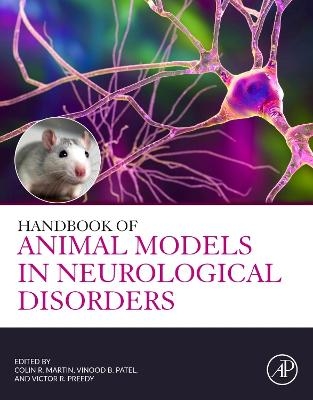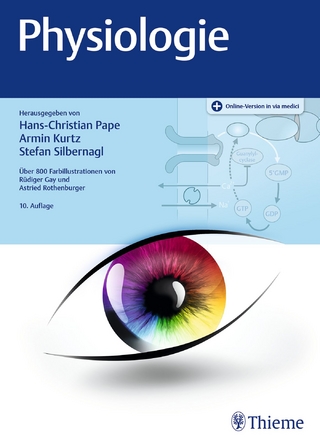
Handbook of Animal Models in Neurological Disorders
Academic Press Inc (Verlag)
978-0-323-89833-1 (ISBN)
Colin R. Martin RN, BSc, MSc, PhD, MBA, YCAP, FHEA, C.Psychol, AFBPsS, C.Sci is Professor of Clinical Psychobiology and Applied Psychoneuroimmunology and Clinical Director of the Institute of Health and Wellbeing at the University of Suffolk, UK. He is a Chartered Health Psychologist and a Chartered Scientist. He also trained in analytical biochemistry, this aspect reflecting the psychobiological focus of much of his research within mental health. He has published or has in press well over 300 research papers and book chapters. He is a keen book author and editor having written and/or edited more than 50 books. These outputs include the prophetic insight into the treatment of neurological disease, Handbook of Behavior, Food and Nutrition (2011), Nanomedicine and the Nervous System (2012), Oxidative Stress and Dietary Antioxidants in Neurological Disease (2020), Zika Virus Impact, Diagnosis, Control and Models (2021), Factors Affecting Neurodevelopment: Genetics, Neurology, Behavior and Diet (2021), Diagnosis and Treatment of Spinal Cord Injury (2022), The Neurobiology, Physiology, and Psychology of Pain (2022) and The Handbook of Lifespan Cognitive Behavioral Therapy: Childhood, Adolescence, Pregnancy, Adulthood, and Aging (2023). Professor Martin is particularly interested in all aspects of the relationship between underlying physiological substrates and behavior, particularly in how these relationships manifest in both acute and chronic psychiatric disorder. He has published original research germane to significant mental health disorders including the areas of schizophrenia, anxiety, depression, self-esteem, alcohol and drug dependency, high secure forensic mental health and personality disorder. He has a keen interest in the impact of postviral illness and is actively involved in clinical research post-Covid pandemic and in particular, the impact of Long Covid on psychological, neurological, physiological and social functioning. He is involved in collaborative International research with many European and Non-European countries. Dr. Patel is a Reader at the University of Westminster. After completing his PhD at King’s College London, he continued his research experience by undertaking his post-doctoral studies in the laboratory of Professor Cunningham in the Department of Biochemistry at the Wake Forest University School of Medicine, (Winston-Salem, NC, USA). This extensive project involved investigating mechanisms of hepatic mitochondrial ribosome dysfunction in alcoholic liver disease (ALD) using biophysical and proteomic techniques. These studies have led to new avenues in determining the pathology of ALD. His teaching areas at both post-graduate and undergraduate levels include clinical biochemistry, investigative pathology and laboratory investigation. Victor R. Preedy BSc, PhD, DSc, FRSB, FRSPH, FRSC, FRCPath graduated with an Honours Degree in Biology and Physiology with Pharmacology. After gaining his University of London PhD, he received his Membership of the Royal College of Pathologists. He was later awarded his second doctorate (DSc), for his contribution to protein metabolism in health and disease. He is Professor of Clinical Biochemistry (Hon) at King’s College Hospital and Emeritus Professor of Nutritional Biochemistry at King’s College London. He has Honorary Professorships at the University of Hull, and the University of Suffolk. Professor Preedy was the Founding Director and then long-term Director of the Genomics Centre at King’s College London from 2006 to 2020. Professor Preedy has been awarded fellowships of the Royal Society of Biology, the Royal College of Pathologists, the Royal Society for the Promotion of Health, the Royal Institute of Public Health, the Royal Society for Public Health, the Royal Society of Chemistry and the Royal Society of Medicine. He carried out research when attached to the National Heart Hospital (part of Imperial College London), The School of Pharmacy (now part of University College London) and the MRC Centre at Northwick Park Hospital. He has collaborated with international research groups in Finland, Japan, Australia, USA, and Germany. To his credit, Professor Preedy has published over 750 articles, which includes peer-reviewed manuscripts based on original research, abstracts and symposium presentations, reviews and edited books.
Section 1: Alzheimer’s Disease and Dementias
1. Caenorhabditis elegans model of Alzheimer's disease: applications to drug screening
2. APPswe/ PS1dE9 mouse model of Alzheimer’s disease: [18F]-florbetaben pet/ct imaging and beyond
3. Rat model of Alzheimer: applications to brain a-beta plaque accumulation
Section 2: Amyotrophic Lateral Sclerosis
4. Murine modelling of familial amyotrophic lateral sclerosis, SOD1G86R: applications to ambroxol HCl
5. Rat Model of amyotrophic lateral sclerosis: SOD1G93A applications to mitochondria
6. Zebrafish model of amyotrophic lateral sclerosis: applications to oxidative stress studies in spinal motor neurons
Section 3: Brain Injury
7. Murine models of traumatic brain injury and knock outs: investigations on hypocretin
8. Rat model of cortical impact traumatic brain injury: applications to studying neural stem cell grafts
9. Porcine modelling of traumatic brain injury: investigating agents such as valproic acid and beyond
Section 4: Cerebral Palsy
10. Animal models of cerebral palsy: a new narrative
11. Rat model of cerebral palsy: applications to studying motor phenotype
12. Rabbit cerebral palsy modelling: applications to studying spinal hyper-excitability
Section 5: Epilepsy
13. Murine modelling of epilepsy: applications to microRNA and hippocampus
14. Kainic acid-induced rat model of status epilepticus: A gamma-aminobutyric acid levels
15. Rats modelling of temporal lobe epilepsy: linking in cognition
Section 6: Headaches and Migraines
16. A new narrative of genetic mouse models of migraine: features and applications
17. Rat model of headache with nitroglycerin: impact of auricular electrical stimulation
18. Nitroglycerin-induced migraine in mice: Nociceptin Opioid (NOP) receptors and beyond
Section 7: Meningitis Rabbit tuberculous meningitis models: applications to neurosciences
19. Experimental pneumococcal meningitis: hippocampal DNA methylation
20. Pneumococcal meningitis modelling in mice
Section 8: Multiple Sclerosis Biological models in multiple sclerosis: a new overview and narrative
21. The mouse model of multiple sclerosis : use of Artemisia dracunculus L.
22. Comparing models of multiple sclerosis: applications to biomarkers
Section 9: Neuroinflammation Modelling neuroinflammation: CXCR2 signalling and myelin repair
23. Lipopolysaccharide- model of neuroinflammation: astrogliosis, microglial activation and beyond
24. Rat model of neuroinflammation: positron emission tomography (PET) tracer for imaging of P2X7 receptors
Section 10: Neurotoxins Animal models in the neurotoxicology of the neurotoxin 2,4-D
25. Toluene as a model neurotoxin in mouse models 1-11-2019
26. Rat model of alcohol-related brain damage: application to thiamine deficiency and cytokines
Section 11: Parkinson’s Disease 1-methyl-4-phenyl-1,2,3,6-tetrahydropyridine( MPTP)-induced mouse model of Parkinson's disease: impact of Valeriana officinalis
27. alpha-synuclein BAC transgenic mice model of Parkinson's disease: the sublaterodorsal tegmental nucleus and beyond
28. Rat model of parkinsonism: the nigro-vagal pathway
Section 12: Peripheral Neuropathy Non-mammalian animal models of peripheral neuropathy
29. Mouse models of peripheral neuropathy: neurogenic molecule NSI-189
30. Rat model of cisplatin-induced peripheral neuropathy: features and applications
Section 13: Prenatal Related Injury Porcine model of intrauterine growth restriction: Applications to the study of the hippocampus
31. Ethanol as a neurotoxin in model primates for in vitro exposure: brain development and beyond
32. Prenatal malnutrition: linking in oxidative stress
Section 14: Stroke Mouse model of ischemic stroke: PET tracers
33. Canine model of stroke: optimizing complex multimodal treatment
34. Porcine Ischemic Stroke and applications to neural stem cells
| Erscheinungsdatum | 02.12.2022 |
|---|---|
| Zusatzinfo | Approx. 125 illustrations (125 in full color); Illustrations |
| Verlagsort | Oxford |
| Sprache | englisch |
| Maße | 216 x 276 mm |
| Gewicht | 450 g |
| Themenwelt | Studium ► 1. Studienabschnitt (Vorklinik) ► Physiologie |
| Naturwissenschaften ► Biologie ► Humanbiologie | |
| Naturwissenschaften ► Biologie ► Zoologie | |
| ISBN-10 | 0-323-89833-5 / 0323898335 |
| ISBN-13 | 978-0-323-89833-1 / 9780323898331 |
| Zustand | Neuware |
| Informationen gemäß Produktsicherheitsverordnung (GPSR) | |
| Haben Sie eine Frage zum Produkt? |
aus dem Bereich


